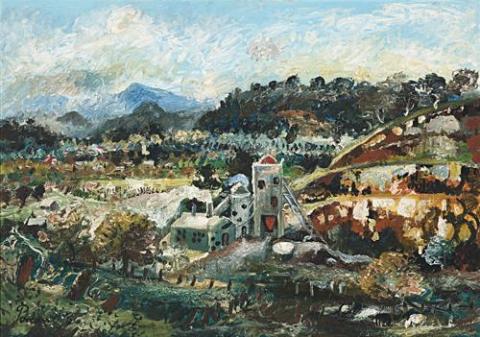LIME QUARRY, LILYDALE, 1956
John Perceval
oil on canvas
80.0 x 113.5 cm
signed and dated lower left: Perceval '56
The Estate of Pro Hart, Broken Hill, New South Wales
Exhibition of Paintings by John Perceval, Australian Galleries, Melbourne, 12–30 November 1956, cat. 29
Art and Labour Exhibition, Geneva Art Museum, Switzerland, June 1957 (label attached verso)
Tasmanian Museum and Art Gallery (label attached verso)
Allen, T., John Perceval, Melbourne University Press, 1992, p. 158
Lime Quarry, Lilydale belongs to that vintage year of 1956 when Perceval produced some of his finest paintings, including the Williamstown and Gaffney's Creek series. Exhibited in his solo show at the Australian Galleries, Melbourne, in November of that year, the thirty paintings were grouped according to their subjects under the headings 'Williamstown' 'Melbourne's Oldest Port' and 'Gaffney's Creek' 'An Old Mining Town'. Tug Boats in a Boat had already been acquired by the National Gallery, which was soon to add Gannets Diving as the winner of the 1957 John McCaughey Memorial Art Prize. Floating Dock and Tugboats became part of the Joseph Brown Collection, and Yankee Boats at Dry Dock entered the Bendigo Art Gallery collection. Lime Quarry's companions included Black Cockatoos Flying Upstream, now in the National Gallery of Australia, Canberra, and Primeval Landscape, You Yangs. In his catalogue introduction, Bernard Smith described Perceval as 'one of the most interesting painters at work in Australia today.'1 The rest is history, with paintings such as Lime Quarry, Lilydale reminding us just how significant were Perceval's achievements.
The art critic for The Age reviewed the exhibition warmly:
'Mr. Perceval is an individualist whose expressionist paintings are executed with extraordinary gusto. They have the air of being painted in a single burst of creative energy. Form is almost entirely ignored and the technique has the appearance of being improvised on the spur of a moment. If somewhat abandoned and turbulent, the immediate effect is visually and emotionally exciting.'2
Writing from a more scholarly viewpoint, Smith noted that Perceval's originality sprang from a combination of innovation and experimentation, with influences ranging from the Old Masters such as Pieter Bruegel the Elder to the German Expressionists. 'But his style, for all that, is his own, a style which, despite its apparent abandon and its general freedom of colour reveals a mature mastery of technique and a sure sense of pictorial control.'3 All these virtues are found in Lime Quarry, Lilydale, the panoramic sweep of the landscape characteristically crowded with images rendered in his distinctive virtuoso brushwork. An atmospheric freshness adds to the liveliness and sense of light-hearted fun, as elements of the buildings metamorphose into eyes, noses, and even a red tongue-filled mouth. The quarry itself had further connections with the Melbourne art world, being, among other things, the source of limestone and marble for many of Danila Vassilieff's sculptures (see lots 6, 7, 8, and 9).
1. Smith, B., 'Foreword', Exhibition of Paintings by John Perceval, Australian Galleries, Melbourne, 1956
2. 'Fine Art for Industry', The Age, Melbourne, 13 November 1956, p. 2
3. Smith, op. cit.
DAVID THOMAS
